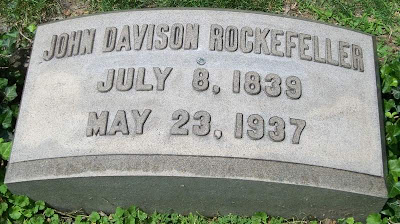 notice the dime above the center 8; not pictured -- 70' white granite obelisk from Barre, Vermont
notice the dime above the center 8; not pictured -- 70' white granite obelisk from Barre, VermontLake View Cemetery is one of the largest graveyards in Ohio. It sits in Cleveland, East Cleveland and Cleveland Heights. It was created for the millionaires (the Republicans and the robber barons, the political and economic victors of the failed War of Secession) on Millionaires’ Row (Euclid Avenue), near Rockefeller’s summer home. The main gate is on Euclid Avenue. In 1869 this was out in the country, beyond the city limits.
Rockefeller was once the world’s richest man, richer than Gates or Slim are to-day. For Orthodox Easter Monday 1914, the Colorado National Guard murdered women and children of strikers, and striking coal miners, in Ludlow. The owner of the largest mine was old John D, and his son, John D. Junior.
The massacre was not well received by the public. Rockefeller hired an early public relations man, ‘Poison’ Ivy Ledbetter Lee (he would later work for nazi businessmen) to create better press. Lee said the burning of the tent village began with an overturned stove. It was the state troops setting the tents afire. Other than raw lies, he had some clever ideas. He had Rockefeller pose for pictures as a kindly old man. Rockefeller became famous for giving children dimes.
Now, the cemetery, and others, like to say, that, people leave dimes and pennies in a superstitious offering. Giving a dime back to John, may have money coming to you. Could not, one coin be there to mock him? What good did the first collecting of the first billion do for John at his death?
Well, Lake View is kept as a park. Italian stone cutters were brought in to carve monuments, and they and gardeners were kept busy. It is a favorite for amateur photographers, and the shutterbugs find the same things to photograph, because the same things appeal to people’s eyes. Jeptha Wade of Western Union Telegraph was the founder. His grandson contracted Louis Comfort Tiffany to furnish a chapel on site. There is a monument, and museum for President Garfield.
 Different tours are conducted through the grounds. Some are of the buried, some are of the 19th century statues, some are of the flora. Some consider it an open air art museum, some an arboretum.
Different tours are conducted through the grounds. Some are of the buried, some are of the 19th century statues, some are of the flora. Some consider it an open air art museum, some an arboretum.Over an hundred thousand are buried there. It was meant for Cleveland’s better citizens. It was non-sectarian, which then meant all protestants. They eased that.
On Ash Wednesday 1908, the Collinwood (or Lake View)* school fire, had 172 children and three adults perish. Many were immigrants. Bishop Ignatius Horstmann had a heart attack during the burials, and died two months later. He is not buried there. In his episcopate 30 parishes were created, 22 of them nationality parishes. He saw people go over to the Polish National Catholic Church, and to an independent parish. He had five thousand slovenes from one parish (N. Y. Times misidentified them as poles) protest outside his home. Many catholics then protested bishop’s actions when they saw it fit. What would they have done to a bishop whom closed parishes, and sold the properties? Well, that was not done then. Horstmann had troubles with the americanists also. He fought Rome for four years to have Fr. Joseph Koudelka made an auxiliary bishop, and vicar general of the Slavs. When this was allowed in January, none of the irish priests attended the consecration. Priests were more unruly then. Now, Cleveland has a tyrant for a bishop, and little opposition to his tyrannies from all but a few parishioners and less priests.
The catholic convert, and ball player, Raymond Chapman is buried there. He was struck in the head by a pitch in 1920. There was an organised protest in allowing a catholic funeral for the ball player. There is no opposition, now, for a catholic to be buried in Lake View. The catholic cemeteries of the diocese are a big till, with several dippers, and a good hiding place. His wife and posthumous daughter are buried in Cleveland’s Calvary, as is his double play partner William Wambsganss. To-day, baseball equipment is left by Chappy’s stone. Years before [1909], a minor league ball player, who also died from a pitched ball was buried in Lake View. For an hundred years he had no stone. Charles Pinkney Jr. last of Collinwood, and the Dayton Veterans. His stone came last year.
________________
*the name of the school was Lake View, in Collinwood
No comments:
Post a Comment